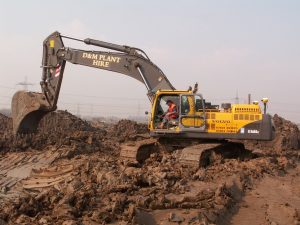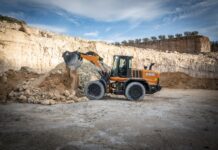According to the UK Department for Business Innovation & Skills, the construction industry can significantly influence almost 47 percent of total carbon dioxide emissions in the UK. Small improvements across UK sites could lead to a big environmental impact, so what role does technology play in reducing emissions in UK construction?
Here Ian Barnes, Director at UK & Ireland’s distributor of Trimble machine control technology SITECH, discusses how technology can minimise construction waste.
Unsurprisingly, the major causes of emissions in the construction industry are energy and material waste. Even before any structure is raised, vast amounts of materials need to be moved in excavating, grading and compacting. According to the National Building Specification, over 400 million tonnes of material is used per year in the UK construction industry, of which 60 million is sent to landfill due to poor management and error.
It’s not just material that’s wasted but energy too. It’s not unusual for rework to be carried out on a job site, as over-excavation is an easy mistake to make. During this process, more fuel is used to operate the equipment and provide electrical power to the building site. Given that much of the equipment in question is designed to move tonnes of material, unnecessary emissions from rework can soon add up.
Finding root cause
The World Green Building Council states that considering the impact a construction project will have on emissions early in the process can significantly increase the potential for reduction. Operation and maintenance will always be limited to building things more efficiently but thinking ahead during the design and planning stages could reduce the amount of work needed altogether.
Software that allows project managers to analyse haul loads, underground structures and simulate builds can help prevent large, wasteful errors that often occur with manual planning. By presenting non-visible factors such as underground plumbing and future building in a visually intuitive way, contractors can be more accurate in their planning and communication. Having a more solid and reliable plan to work towards will not only save money, it will also reduce the time needed to finish the job — therefore reducing the overall emissions.
Reductions at every stage
Even after the planning stage, there are steps that contractors can take to keep emissions to a minimum. For example, digitalising communication and using connected sensors reduces the need for face-to-face meetings, along with the associated travel. Not only does this reduce vehicle emissions, but it can decrease the chance of miscommunication and errors during construction as all of the details of the build are accessible digitally at any time.
Using Grade Control Systems for construction equipment, such as Trimble Earthworks, can also have a positive effect on emissions. They allow operators to maintain a constant depth, slope and elevation on excavators using digital systems with reduced manual inputs. This lessens the chance of human error while increasing the efficiency of the construction process. Integrating these systems is as simple as adding control boxes, angle sensors and body sensors to existing excavators.
With the right technologies at hand, project managers and contractors can significantly improve the accuracy and efficiency of their builds, reducing emissions and improving their productivity at the same time. To learn how Grade Control Systems can increase the efficiency of your fleet, visit https://www.sitechukandireland.com/grade-control/

















